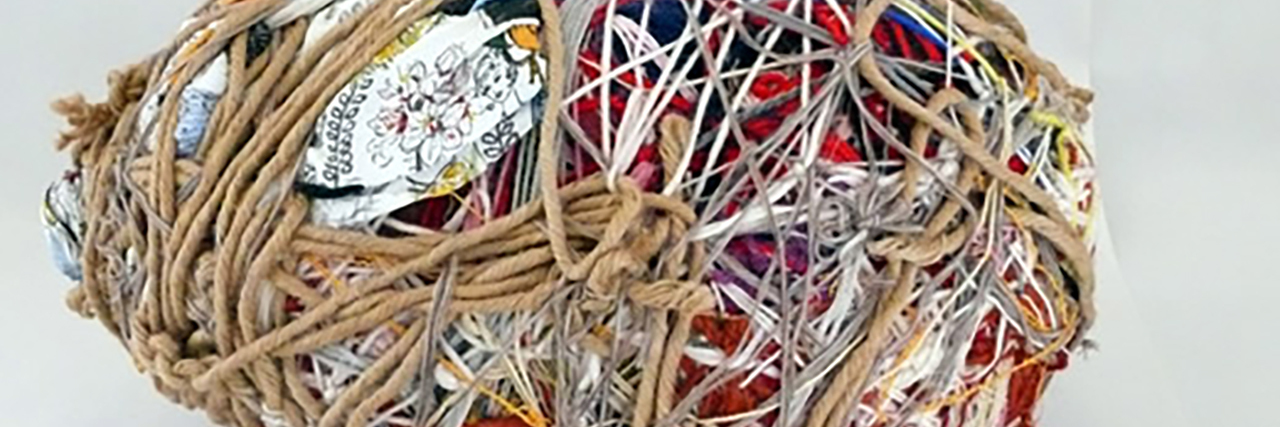
For the past nine months I’ve had the same black and white image on my desk. It’s a woman with Down syndrome embracing a large sculpture. Eyes closed, face buried, she nuzzles the layers of thick fabric wrapped in such a way that the piece looks like an ancient totem — deep, rich, and full of power. Whether the subject is giving her strength to the sculpture or drawing strength from it, one thing is very clear from the photograph: there is a deep connection between object and human, and the observer can do little to sever it.
I first came across Judith Scott and her artwork during a contemporary art class my final semester at university. Like her work, the story of Scott’s life sears its own scar in your mind. Born in the 1940’s, Judith lived happily with her able-bodied twin Joyce until the age of 7 when their parents decided to institutionalize Judith with no warning. Three decades later Joyce found her twin in an abusive institution and ultimately became her legal guardian.
That story alone would be enough to set up the perfect made-for-TV movie. But as is so often the case, nothing ends when we expect it. During those lonely years Judith managed to pick up an obsession for fibers and fabrics, often tearing at her clothes or destroying items. A symptom that was easily dismissed as disturbed or a compulsion ultimately became the earliest indicator of her life’s work. Today Scott’s fiber sculptures sell for tens of thousands of dollars.
A woman who was once tested to have an IQ of 30 became an internationally renowned sculptor.
As writer I often struggle with balancing the story I want to tell with the story that’s going to sell. In this case, it’s clear to me the story that will sell. Judith Scott in an inspiration. Anyone can make art. Anyone can have creative value. We must not be blind to other people’s talents. Institutionalizing people is bad; it’s a good thing society has changed its attitudes.
Which is all fair enough, but doesn’t make for a very good play. We’ve heard it all before.
When I first began writing Scott’s story, it was clear to me that we didn’t need another narrative about a person with a disability overcoming her condition.
We needed someone we could wrestle with.
In many ways the character I created, Genie, who is loosely based on Judith Scott, was easy to write. As Mamet puts it “your character wants one thing and one thing only.” Well, Genie wants to make art. There is no moral weakness, nothing she needs to learn to make her life better. Everyone else just needs to stay out of her way.
More and more I’m finding as a writer and performer with a disability, the things that hold me back are not issues surrounding my body. It is not the fact that I type at about 10 words per minute, or that I rely on someone else to tie my shoes and do my hair every morning.
The greatest obstacles placed on artists with disabilities often involve the refusal to respect their time, energies, and even boundaries as simply “artists.” It comes in the form of a thousand little microaggressions and mini injustices which ensure inequality. A school not providing accommodation that is required by law, somebody uncomfortable because a person with a disability is asserting their rights rather than acting “submissive,” or putting the artist up for yet another diversity scheme because “it might be a good one” rather than actually making some phone calls with your mainstream contacts.
This is the story I want to tell. The story of Genie (and Judith) is not inspirational in the sense we’ve become accustomed to. It is a story that asks the audience to examine how we actively contribute and are complicit in a society which harms people more than their disabilities ever could. Genie is in no way easy to live with, but nor is her work easy to classify. It is our job therefore to respect both artist and work, rather than thrust our own expectations on both.
When Judith Scott died in the spring of 2005, she had become one of the most esteemed artists worldwide. Yet her working process never altered. She did not go to her openings, had relatively little use for the money her work brought in, and her favorite food was bananas, a lasting impact of having her teeth cut out by an institution in order to make her “easier to handle.”
For two decades after being released from the institution, Scott worked almost every hour quietly in her studio, wrapping fabric into form and hypnotic beauty. Scott’s life and her work pulls us away from our own predetermined judgments and toward a fundamental language we are born understanding.
It is a language we lose the ability to translate when we expect to hear gibberish instead.
We want to hear your story. Become a Mighty contributor here.
Photos via Joyce and Judith Scott’s website.

